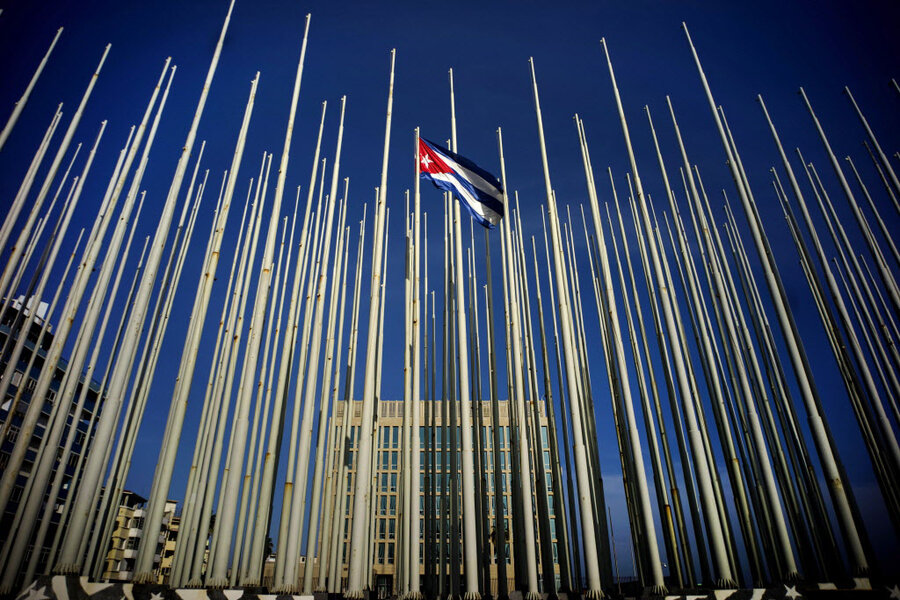Amid symbolic opening of Cuban embassy, points of friction remain
Loading...
US relations with Cuba resumed in modest fashion in the early hours of Monday morning after more than five decades of frosty relations that outlasted the Cold War that inspired them.
The countries have been at symbolic and ideological loggerheads through five presidencies – even as Cuba’s political and military significance waned after the end of the Cold War. In December the countries agreed to resume normal diplomatic relations, and that agreement came into effect just after midnight Sunday. In that instant, the diplomatic missions of each nation were upgraded from “interests sections” to embassies. At the US State Department, a maintenance worker in a short-sleeve shirt hung the Cuban flag – between Croatia and Cyprus – in the building’s lobby, the Washington Post reported, the closest event to a formal ceremony announcing Cuba’s new membership in the club of nations with which America has formal diplomatic relations.
While there may not have been many physical signs of normal relations between Cuba and the United States, there were several on social media. Shortly after midnight, the Cuban Interests Section in Washington, D.C., switched its Twitter account to say “embassy." In Havana, the US Interests Section there changed its Facebook profile picture to an image that says US EMBASSY CUBA. Conrad Tribble, the deputy chief of mission for the US in Havana, tweeted: “Just made the first phone call to State Dept. Ops Center from United States Embassy Havana ever. It didn’t exist in Jan. 1961.”
It was in 1961 when then-President John F. Kennedy severed ties with the communist island nation then led by the young revolutionary Fidel Castro. The US kept no diplomatic presence in the country at all until 1977.
Cuba has been operating an interests section out of a 16th Street mansion in Washington, under the auspices of the Swiss Embassy. The building will host a formal ceremony this morning, during which Secretary of State John Kerry will meet his counterpart, Cuban Foreign Minister Bruno Rodriguez, to address reporters. It will be the highest-level visit by a Cuban envoy to the country outside of events at the United Nations, according to the Post. Some 500 people are expected to attend the ceremony, including a 30-member delegation of diplomatic, cultural, and other leaders from Cuba.
While this may be the friendliest the two nations have been in decades, points of friction still remain. Cuba wants to see an end to the 53-year trade embargo, while the US wants to see improvements on human rights and democracy. Both countries have made claims for economic reparations.
The longstanding ideological differences between the two countries seemed to prevent diplomatic relations resuming sooner. President Obama had sought to engage Cuba since he first took office – his administration have progressively loosened restrictions on travel and remittances to the island – but the larger effort to formalize relations were frustrated for years by Cuba’s imprisonment of Alan Gross, a contractor for the US Agency for International Development, on espionage charges.
Months of secret negotiations led to Mr. Gross’ release last December – in exchange for the release of the remaining members of an alleged Cuban spy ring jailed in the US – and Mr. Obama and Cuban President Raúl Castro announced they would resume full diplomatic relations.
The process still dragged on until April this year, when the US removed Cuba from its list of state sponsors of terrorism, a move The Monitor’s Howard LaFranchi reported was “years overdue.”
Christopher Preble, vice president for defense and foreign policy studies at the Cato Institute in Washington, told The Monitor then: “The best reason for removing Cuba from the state sponsor of terrorism list may be because Cuba does not appear to be a state sponsor of terrorism.”
Carlos Alzugaray, a longtime Cuban diplomat and analyst, told the Associated Press that while the change in relations this morning is a “historic” moment, “there are bound to be conflicts.”
“But the way that you treat the conflict has completely changed,” he added. “The significance of opening the embassies is that trust and respect that you can see, both sides treating the other with trust and respect.”
The reason for this may be as much about political and economic changes in Latin America as any major changes in the US and Cuba.
The Monitor reported in March that the ailing Venezuelan economy – Cuba’s biggest benefactor since the dissolution of the Soviet Union – was making normal relations with America look a lot more palatable.
Michael Shifter, president of the Inter-American Dialogue in Washington and an adjunct professor of Latin American studies at Georgetown University, told The Monitor that “Cubans are acutely aware that Venezuela is in an unrelenting crisis and not going to get better any time soon.”
It’s also becoming harder for the Cuban government to plausibly blame the US for all the country’s troubles, as it has in the past, Mr. Shifter said.
The Cuban government are likely to maintain their anti-American rhetoric, experts say, as they seek to keep the pace of change in the country at a manageable level. But that rhetoric is proving far less effective.
“That kind of rhetoric has less and less resonance,” he said. “It’s very hard to find anyone for whom that rhetoric has any echo these days.”








